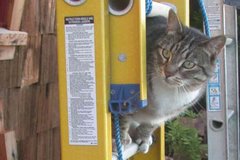Cores are being described now!
The official CASEIS Cruise Blog is located here: http://www.ipgp.fr/caseis This official blog is written by my shift-mate Lola Johannes.
We started describing cores today!
- Here are all but one of the core sections form our first core CAS16-01PC. The top of each core is on the far side of the table and the uppermost section is on the left. The core on the right is more gray and is probably from the Pleistocene, while the more brown cores are from the Holocene. The missing core section (being analyzed) shows the transition between the upper brown/red sediments and the lower gray sediments. These cores are full of turbidites and hemipelagites. For example, on the lowest section, there is a dark section about 40% of the way up from the base that gets lighter in value upwards. There is another example of this about 60% up from the base of this core section. The base of these darker layers are the bases of some turbidites.
- Here Dr. Ratzov is training students how to "log" a core with a core sheet. You met my shift-mates in the last blogpost here.
- Here are two shiftmates from the previous shift finishing up a core description (Kay is on the left, with the lab coat). We can see that it is fun to describe the sediment stratigraphy (while I think it is fun, they were actually smiling because everyone has fun having their photo being taken).
- Here Dr. Beck is training two more of my shift mates on how to prepare a lithostratigraphic log. Julia from a different shift is observing and finds it funny that I keep taking photos of everyone.
- Here my cabin mate Quentin (from Quebec) is describing a core section.
- Here we can join in the pleasure of seeing the first core split and cleaned. After preliminary observations, these cores are quite promising to hold a vast treasure of geological data. I cannot wait until we see the next core!!! And, by the look on Herve's and Nathalie's faces, neither can they!
- Here is a panorama from my cell phone showing the core section (on the left) that I was describing (section IV, the fourth section from the top) and a section that we saw the previous shift describing in the photo above. This photo is distorted, but gives us an idea of what is in the core. The section that I described is the core that does not appear to have as much layering (laminations).
- Here is the lithologic log from my section.

- After the cores equilibrated with the temperature of the MST room, they were analyzed. Then they were cut by a paired saw set up, lengthwise, and split into an archive and a working half. I will post photos of that when we do this during our shift (or if I am awake when someone else does it). But, before we started, we had a fire drill. This took us to plage 6 (deck 6), where we got to watch the streamer in action. I know it is not exciting from this view, but we are collecting seismic data that will be important to interpret the structural geology and relations between the upper plate and megathrust in this location. Below is a photo of Drs. Nathalie Fueillet and Guillaume St-Onge. Nathalie is smiling because she is pleased with our excellent progress. We have collected two great cores (more on that below) and are acquiring high quality seismic data. I will post more on the seismic data once it is analyzed and prepared for (preliminary) presentation.

- After the core is split, the archive half is scanned with a real color (RGB) scanner. Then the MST instrument is reconfigured to collect photospectometry and point magnetic susceptibility data (high resolution mag sus). As I mentioned, I will talk more about the initial full core MST analyses when it happens during my shift (so I can take photos). The photospectrometry allows spectral analyses of the cores. Below is the the configuration showing the spectrometer on the left (beige and tan) and the point mag sensor (the white device) immediately to the right. Not the radioactive sign. That is the 137Cs radiation source used to estimate the down-core density profile. The core moves from the right to the left.
- Here is the computer showing the profile of mag sus and average reflectometry.
- We started by having Georgi train the students on how to describe a core. There are a number of ways to do this and he updated my description so that my description was consistent with others. Here is a photo of Georgi training the students.













No comments:
Post a Comment